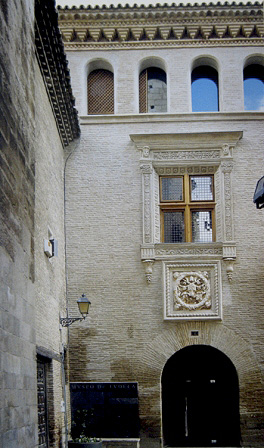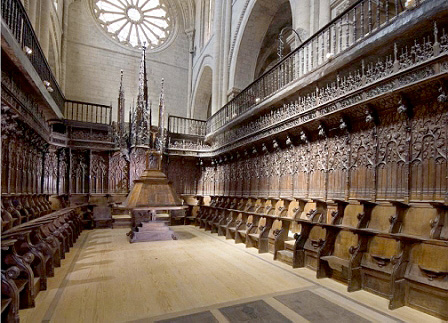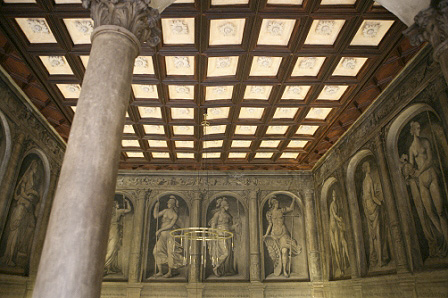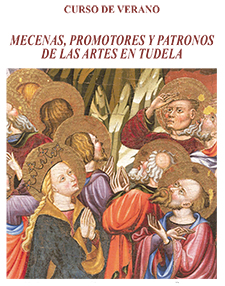PATRONS, PROMOTERS AND PATRONS OF THE ARTS IN TUDELA
26 August 2014
The great patrons of the Renaissance, mirror of Humanism
Mrs. María Concepción García Gainza. Chair of Heritage and Art of Navarre.
During the 16th century the city of Tudela went through a period of splendor to the point that it can be considered a focus of Humanism of importance in relation to the powerful center of Zaragoza and the lesser center of Tarazona. Tudela will maintain close ties with the latter because both cities belong to the diocese of Tudela-Tarazona. This condition will favor continuous artistic relations between them with a repeated transfer of artists and decorative and architectural projects, all of which makes it possible to speak of symmetrical projects developed on both sides of the border as indicated by J. Criado.
Relations with Italy, where the new cultural model called Humanism and Renaissance art originated, will be closely maintained by some important figures of the time such as Don Pedro Villalón, Dean of the collegiate church, Domingo and Martín de Gaztelu, both secretaries of the emperor and Don Lope de Soria, ambassador of Charles V in Venice and Genoa. For its part, the Study of Grammar that operated in Tudela was in charge of the teaching of classical languages and authors and had renowned teachers such as Melchor Enrico. Among his disciples the figure of Jerónimo Arbolanche (1546-1572) stands out, humanist and merchant author of the Abidas, a work that has mythology as an essential source in which the author makes authoritative quotations to Dante, Petrarca, Juan de Mena, Alciato or Juan de la Encina. It is also important to know the training of some libraries such as that of the Magallón family, which included Venetian editions of classical works, or that of Miguel de Eza y Veraiz, who had among his books of diverse content, El Cortesano by Baltasar de Castiglione, as documented by M. J. Tarifa.
Much had to do in the splendor of Humanism in Tudela the actions of four important patrons and promoters who expressed their ideas and programs in their religious, charitable or palatial enterprises, as will be seen below. The most outstanding promoter is undoubtedly Don Pedro Villalón de Calcena who was Dean of Tudela, prototype of a cultured and refined Renaissance prince, who had been in Rome where he became a figure close to Pope Julius II of whom he was papal chamberlain, apostolic prothonotary and relative of the Pope. In 1507, while in Rome, he obtained the canonry of Tarazona and that same year Julius II, wishing to repay Pedro Villalón for his loyalty and many services, named him Dean of Tudela. The Tudela chapter and the municipality refused to give him possession and after a long litigation with the support of the Pope, he took possession in 1511, although he remained with Julius II until his death in 1513, the year in which, already in Tudela, signature the constitutions and statutes of the collegiate church of Santa María. Villalón always remained faithful and report to Julius II, representing his papal coat of arms in the enterprises he would carry out. Thus in 1515 he enlarged and remodeled the Dean's palace with staircase and chapel as well as its main façade in whose window he used candelieri ornamentation. This was the beginning of the Renaissance in Tudela, of which the Dean can be considered the introducer. The same year Villalón undertook his second great project business, the choir stalls of the collegiate church, which he paid for with financial aid from the parishioners. To carry it out, the Dean chose a French master, Esteban de Obray, a native of Saint-Thomas, near Rouen, who did it with financial aid of other French collaborators. The choir stalls were carved in the "modern" style, that is, in the late Gothic style, although combined with "Roman" motifs, and represent an advance with respect to the 16th century choir stalls of San Pablo in Zaragoza and San Pedro el Viejo in Huesca. The choir was finished in 1522 by closing it with a wooden grille in which the Renaissance openly triumphs.

Façade of the Dean's Palace of Tudela,
built in 1515 by the dean Villalón

Chairs of the cathedral of Tudela,
made in 1515 by Esteban de Obray at the request of the dean Villalón.
business The construction of the chapel of San Martín in the cathedral of Tudela, the most important chapel of the Second Renaissance in the city, is owed to Martín de Mezquita, canon treasurer of Tarazona. Built under his patronage, the altarpiece, the stained glass windows and the grille, with repeated allusions to the Treaty of Serlio that he owned, was made in imitation of the Talavera Chapel of the cathedral of Tarazona, both twin enterprises on either side of the border.
Outside the scope of the cathedral, it is worth mentioning the promotional work of Don Miguel de Eza y Veraiz, Knight of Alcántara, who owned a rich collection of sumptuous objects and a considerable Library Services as we have seen. In his will he dedicated his entire fortune to the construction of the Hospital de Santa María de Gracia, which was to be built on the outskirts of the city for reasons of hygiene and whose design would be given by Martín de Gaztelu, a master from Zaragoza. A large church covered with starred vaults with wooden fleurons is preserved in relation to the roof of the monastery of Tulebras. Its tombstone is next to the presbytery.
Finally, a beautiful example of Renaissance palace architecture is due to the promotion of an important lineage of Tudela, the Magallón family, related by marriage to the Villalón and Soria families. The palace with a beautiful courtyard as a cortile and a grand staircase is a good example of the palatial architecture of the Ebro Valley. Of great significance are the paintings that adorn three sides of the staircase box made in grisaille and representing a humanistic program of twelve Illustrious Women, located four on each side under arches. The four women on the right side are mythological goddesses, those on the central panel are warrior women from Antiquity and the four on the third side are chaste women also taken from Greco-Latin history and legend. They are the work of the Piacenza painter Pietro Morone, who was directly inspired by Raimondi's engravings. A set of the purest Humanism that we owe to the promotion of Don Pedro Magallón y Villalón and his wife Laura de Soria. It is a unique program in the Spanish Renaissance.

Staircase of the Magallón Palace
Iconographic program with the Illustrious Women, work of Pietro Morone
PROGRAM
Tuesday, 26th August
Three exceptional altarpieces for three promoters
Ms. Mercedes Jover Hernando. Museum of Navarre
The great patrons of the Renaissance, a mirror of humanism
María Concepción García Gainza. Chair of Navarrese Heritage and Art
Wednesday, 27th August
Around the patron saints
D. Ricardo Fernández Gracia
Chair of Navarrese Heritage and Art
Patrons and patrons of Tudela silverware
D. Ignacio Miguéliz Valcarlos
UNED Pamplona
Patrons and Patronages in the Collegiate ( visit guidada)
Ms. María Josefa Tarifa Castilla. University of Zaragoza
Thursday, 28th August
Town planning and civil architecture
D. Carlos Carrasco Navarro. Doctor in History of Art
The great men of the Enlightenment
D. Pablo Guijarro Salvador. Chair of Navarrese Heritage and Art.
Monarchy, patrons and nuns in the Company of Mary ( visit guided)
D. Ricardo Fernández Gracia
Chair of Navarrese Heritage and Art

